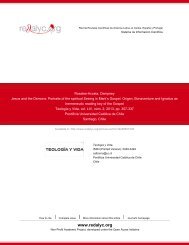A Key Concept in Modern Translation Theory - Redalyc
A Key Concept in Modern Translation Theory - Redalyc
A Key Concept in Modern Translation Theory - Redalyc
You also want an ePaper? Increase the reach of your titles
YUMPU automatically turns print PDFs into web optimized ePapers that Google loves.
66 EQUIVALENCE REVISITED: A KEY CONCEPT IN MODERN TRANSLATION THEORY<br />
undeniably lies <strong>in</strong> the existence of an orig<strong>in</strong>al text, and the need to present that<br />
text <strong>in</strong> other words. [They] have noth<strong>in</strong>g to say about the relationship between<br />
orig<strong>in</strong>al and translated text, nor can they shed light on whether a translation is <strong>in</strong><br />
fact a translation and not a version, an adaptation or another secondary textual<br />
product derived from an orig<strong>in</strong>al text” (p.6). Some authors with<strong>in</strong> this approach<br />
are: Nida 1964; Nida and Taber 1969; Carroll 1966; MacNamara 1967.<br />
Literature-oriented Approaches: Descriptive <strong>Translation</strong> Studies. “In<br />
this approach the existence of a source text that served as a basis for the translated<br />
text is thus played down to a considerable extent” (p.7). For House, the basic<br />
problem <strong>in</strong> this approach is “how one is to determ<strong>in</strong>e when a text is a translation<br />
and what criteria one is to use for evaluat<strong>in</strong>g a translation –but these are questions<br />
which a descriptive translation researcher would probably never ask, s<strong>in</strong>ce he<br />
would typically start from the hypothesis that a translation belongs exclusively to<br />
the literary system of the target l<strong>in</strong>guaculture” (ibid). The major problem with<br />
tak<strong>in</strong>g this approach is summarized by House <strong>in</strong> one question: “On which criteria<br />
are we to legitimately say that one text is a translation, another one not, and what<br />
exactly are the criteria for judg<strong>in</strong>g the merits and weaknesses of a given<br />
‘translation’?” (p.8). Some authors with<strong>in</strong> this approach are: Even-Zohar and<br />
Toury 1981; Hermans 1985; Toury 1985; van den Broek 1985/1986; Holmes<br />
1988; Bassnett and Lefevere 1990.<br />
Post-<strong>Modern</strong>ist and Deconstructionist Approaches. Theorists <strong>in</strong> this<br />
approach “undertake to unmask the unequal power relations that are reflected <strong>in</strong><br />
the translation directions from and <strong>in</strong>to English, and the promotion of further<br />
English language hegemony through one-sided translations from English and an<br />
ever decreas<strong>in</strong>g number of foreign texts be<strong>in</strong>g translated <strong>in</strong>to English” (p.9).<br />
“No answers are sought for the question of when a text is a translation, and<br />
when a text belongs to a different textual operation” (p.11). Some authors with<strong>in</strong><br />
this approach are: Graham 1985; Spivak 1988, Benjam<strong>in</strong> 1989; Cheyfitz 1991;<br />
Venuti 1992; Niranjana 1992; Gentzler 1993; Bhabha 1994; Arrojo 1994.<br />
Functionalistic and Action and Reception-theory Related Approaches.<br />
“In their functionalistic or “Skopos-theory” of translation, Reiss and Vermeer<br />
(1984) claim that it is the ‘skopos’ , i.e., the purpose of a translation, which is<br />
overrid<strong>in</strong>gly important. Given the primacy of the purpose of translation, it is the<br />
way target culture norms are heeded that is the most important yardstick for<br />
assess<strong>in</strong>g the quality of a translation” (p.12). More relevant for House’s discussion<br />
“is the failure of the authors to spell out exactly how one is to determ<strong>in</strong>e whether<br />
a given translation is either adequate or equivalent let alone how to l<strong>in</strong>guistically
















